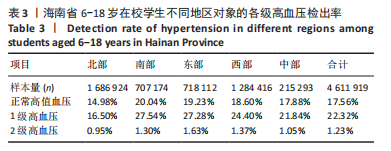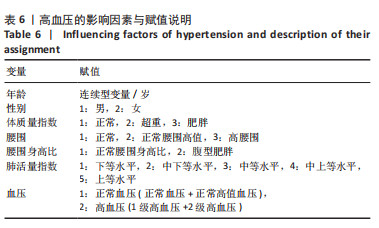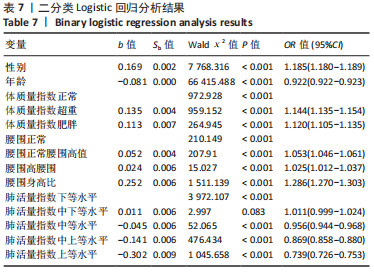Chinese Journal of Tissue Engineering Research ›› 2023, Vol. 27 ›› Issue (23): 3728-3735.doi: 10.12307/2023.532
Previous Articles Next Articles
Prevalence and influencing factors of hypertension in school students aged 6-18 years in Hainan Province
Wang Weitong1, Ouyang Fanxian2, Li Jun3, Li Jiaqi3
- 1International School of Public Health and Whole Health, Hainan Medical University, Haikou 571199, Hainan Province, China; 2Department of Nosocomial Infection Management and Disease Control, The Second Affiliated Hospital of Hainan Medical University, Haikou 570311, Hainan Province, China; 3Hainan Institute of Health Care for Primary and Secondary School Students, Haikou 570000, Hainan Province, China
-
Received:2022-08-10Accepted:2022-08-30Online:2023-08-18Published:2023-01-16 -
Contact:Ouyang Fanxian, MD, Chief technician, Department of Nosocomial Infection Management and Disease Control, The Second Affiliated Hospital of Hainan Medical University, Haikou 570311, Hainan Province, China -
About author:Wang Weitong, Master candidate, International School of Public Health and Whole Health, Hainan Medical University, Haikou 571199, Hainan Province, China -
Supported by:Social Development Science and Technology Project of Hainan Province, No. SF201313 (to OFX); Applied Technology Research and Development Special Project of Hainan Province, No. ZDXM2014063 (to OFX)
CLC Number:
Cite this article
Wang Weitong, Ouyang Fanxian, Li Jun, Li Jiaqi. Prevalence and influencing factors of hypertension in school students aged 6-18 years in Hainan Province[J]. Chinese Journal of Tissue Engineering Research, 2023, 27(23): 3728-3735.
share this article
Add to citation manager EndNote|Reference Manager|ProCite|BibTeX|RefWorks

2.1 海南省6-17岁在校学生各年龄段男生和女生各级高血压检出率 从监测数据库中导出体检时间为2013-01-01/2020-12-31并且身高和体质量信息完整的6-18岁儿童青少年体检信息共6 571 214条信息,通过填补缺失值,剔除离群值,最终纳入6 253 567条信息(删除率为4.83%),其中男生3 408 734名(54.51%),女生2 844 833名(45.49%)。全省正常高值血压、1级高血压、2级高血压检出率分别为:17.62%(男:18.89%,女:16.09%)、22.56%(男:21.55%,女:23.77%)和1.23%(男:1.07%,女:1.43%)。 由于18岁青少年与6-17岁儿童青少年血压评判标准不同,所以分析各年龄段男女生各级血压检出率时只保留6-17岁儿童青少年体检信息共6 199 853条信息,其中男生3 379 614名(54.51%),女生2 820 239名(45.49%)。各年龄段男生女生各级高血压检出率见表1。"
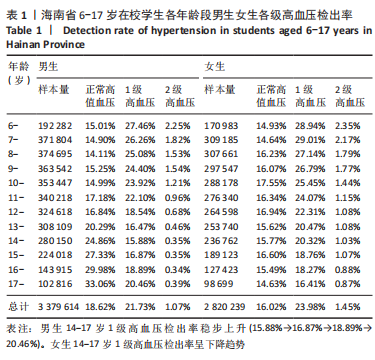

采用Mann-Whitney U检验法观察各年龄段男女生间各级高血压是否具有相同的分布。平均秩次分析结果显示:(男生14-17岁平均秩次)-(女生14-17岁平均秩次)差值逐渐增大,说明男生14-17岁血压严重程度随年龄增长较同龄女生血压严重程度越来越严重。各年龄段男女生各级高血压分布有显著性差异(P < 0.001)。总体上看,女生血压严重程度略大于男生,并且6-13岁女生组的血压严重程度高于男生,而14-17岁男生组的血压严重程度高于女生。男生13岁后正常高值血压检出率涨幅明显大于女生。男生14-17岁后1级高血压检出率稳步上升。 2.2 海南省6-18岁在校学生不同检测年份和不同地区各级血压检出率 根据海南省各市县地理位置,将海南省各市县划分为5个区域分别为:北部(海口市)、南部(三亚市)、东部(文昌市、琼海市、万宁市、陵水黎族自治县)、西部(澄迈县、临高县、洋浦经济开发区、儋州市、昌江黎族自治县、东方市、乐东黎族自治县)、中部(定安县、屯昌县、琼中黎族苗族自治县、保亭黎族苗族自治县、五指山市、白沙黎族自治县)。根据海南省中小学卫生保健所资料,选取2014-2020年有连续监测数据的9个地区,分别为北部(海口市)、南部(三亚市)、东部(琼海市、陵水黎族自治县)、西部(临高县、儋州市、昌江黎族自治县)和中部(保亭黎族苗族自治县、五指山市)。 2.2.1 海南省6-18岁在校学生不同年份的各级血压检出率 采用Kruskal-Wallis H检验观察不同年份间各级高血压是否具有相同分布。平均秩次分析结果显示,7年间各级高血压分布有显著性差异(P < 0.001)。采用Nemenyi法检验各年份之间各级高血压是否具有相同分布。平均秩次分析结果显示,除2015年与2019年各级高血压分布差异无显著性意义,其他年份进行两两比较均有显著性差异(P < 0.001)。2014年血压严重程度最低,2014-2018年血压严重程度不断增高,2019-2020年血压严重程度下降。不同年份各级高血压检出率见表2。"
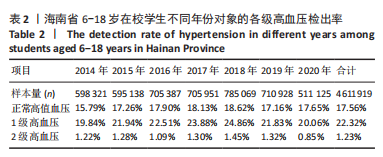

2.3 不同因素与各级高血压的相关性和多分类Logistic回归分析结果 2.3.1 不同级别体质量指数对不同级别血压的影响 经Spearman秩相关分析显示,rs=0.05,P < 0.001,提示体质量指数不同程度与各级高血压呈正相关关系,但正相关关系并不密切。经多分类Logistic回归分析,结果显示儿童青少年出现超重,发生正常高值血压和1级高血压的风险较大,分别是体质量指数正常儿童青少年的1.333倍(OR=1.333,95%CI:1.323-1.343,P < 0.001)、1.333倍(OR=1.333,95%CI:1.324-1.343,P < 0.001);儿童青少年出现肥胖,发生2级高血压的风险较大,是体质量指数正常儿童青少年的1.752倍(OR=1.752,95%CI:1.693-1.812,P < 0.001),见表4。"
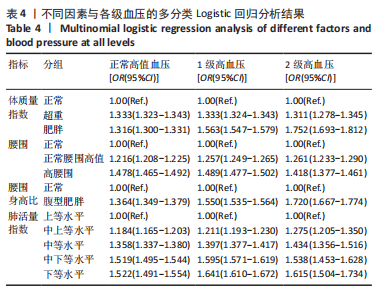
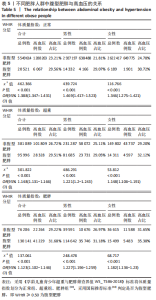
2.3.2 腰围不同等级对不同级别血压的影响 经Spearman秩相关分析显示,rs=0.05,P < 0.001,提示腰围不同程度与各级高血压呈正相关关系,但相关关系并不密切。经多分类Logistic回归分析,结果显示儿童青少年腰围在正常腰围高值范围时,发生1级高血压和2级高血压的风险较大,分别是正常腰围儿童青少年的1.257倍(OR=1.257,95%CI:1.249-1.265,P < 0.001)和1.261倍(OR=1.261,95%CI:1.233-1.290,P < 0.001);儿童青少年腰围在高腰围范围时,发生1级高血压的风险较大,是正常腰围儿童青少年的1.489倍(OR=1.489,95%CI:1.477-1.502,P < 0.001),见表4。 2.3.3 不同等级腰围身高比对不同级别血压的影响 经Spearman秩相关分析显示,rs=0.039,P < 0.001,提示腰围身高比不同程度与各级高血压呈正相关关系,但相关关系并不密切。经多分类Logistic回归分析,结果显示儿童青少年出现腹型肥胖,发生2级高血压的风险较大,是正常腰围身高比儿童青少年的1.720倍(OR=1.720,95%CI:1.667-1.774,P < 0.001),见表4。 2.3.4 不同等级肺活量指数对不同级别血压的影响 经Spearman秩相关分析显示,rs=-0.047,P < 0.001,提示体质量指数不同程度与各级高血压呈负相关关系,但相关关系并不密切。多分类Logistic回归分析结果与Spearman秩相关分析结果相似,显示随着儿童青少年肺活量指数水平下降,发生正常高值血压、1级高血压、2级高血压的风险增大,见表4。 2.3.5 不同肥胖人群中腹型肥胖与高血压的关系 无论体质量指数为正常、超重或肥胖的儿童青少年出现腹型肥胖时,发生高血压的风险均较大(P < 0.001),见表5。"
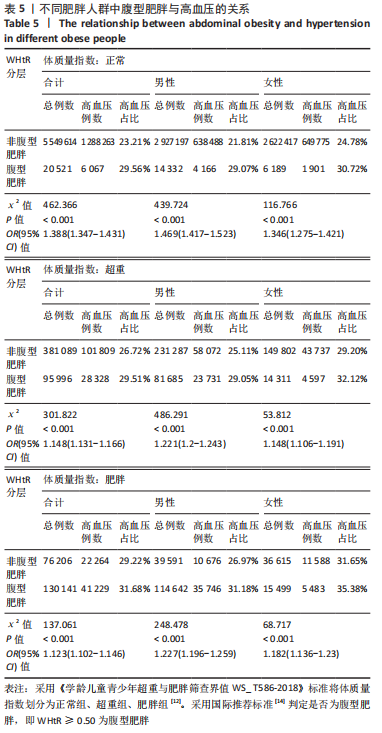

从表7可见,女生(OR=1.185,95%CI:1.180-1.189,P < 0.001)、体质量指数(超重:OR=1.144,95%CI:1.135-1.154,P < 0.001;肥胖:OR=1.120,95%CI:1.105-1.135,P < 0.001)、腰围(正常腰围高值:OR=1.053,95%CI:1.046-1.061,P < 0.001;高腰围:OR=1.025,95%CI:1.012-1.037,P < 0.001)、腰围身高比(腹型肥胖:OR=1.286,95%CI:1.270-1.303,P < 0.001)为儿童青少年高血压危险因素。年龄、肺活量指数(中等水平:OR=0.956,95%CI:0.944-0.968,P < 0.001;中上等水平:OR=0.869,95%CI:0.858-0.880,P < 0.001;上等水平OR=0.739,95%CI:0.726-0.753,P < 0.001)为儿童青少年高血压保护因素,肺活量指数指数水平越高发生儿童青少年高血压的风险越小。"

| [1] 马丽媛,王增武,樊静,等.《中国心血管健康与疾病报告2021》关于中国高血压流行和防治现状[J].中国全科医学,2022,25(30): 3715-3720. [2] YANG L, MAGNUSSEN CG, YANG L, et al. Elevated blood pressure in childhood or adolescence and cardiovascular outcomes in adulthood: a systematic review. Hypertension. 2020;75(4):948-955. [3] MEER R, BOATENG D, KLIPSTEIN-GROBUSCH K, et al. Incidence and correlates of high blood pressure from childhood to adulthood: the Birth to Twenty study. J Hypertens. 2022;40(2):274-282. [4] 刘宏彦,冷俊宏,王蕾棽.肥胖对儿童青少年健康影响的研究进展[J].中国城乡企业卫生,2022,37(2):38-41. [5] WANG L, SONG L, LIU B, et al. Trends and status of the prevalence of elevated blood pressure in children and adolescents in China:a systematic review and meta-analysis. Curr Hypertens Rep. 2019; 21(11):88. [6] 董彦会,邹志勇,王政和,等.中国2014年7-18岁儿童青少年血压偏高流行的区域分析[J].中华流行病学杂志,2017,38(7):931-937. [7] HU J, SHEN H, WU JZ, et al. Prevalence of high blood pressure and high normal blood pressure among 7- to 17-year-old children and adolescents in developed regions, China from 2014 to 2017: using new national blood pressure reference for Chinese children and adolescents. J Hum Hypertens. 2019;33(5):400-410. [8] YE X, YI Q, SHAO J, et al. Trends in prevalence of hypertension and hypertension phenotypes among chinese children and adolescents over two decades (1991-2015). Front Cardiovasc Med. 2021;8:627741. [9] 欧阳范献,卜平凤,周家仍,等.海口市初中生的年龄、性别、身高分布特点及12-14岁组高血压现患率调查[J].海南医学,2016, 27(14):2385-2388. [10] 范晖,闫银坤,米杰.中国3-17岁儿童性别、年龄别和身高别血压参照标准[J].中华高血压杂志,2017,25(5):428-435. [11] 刘力生,吴兆苏,王继光,等.中国高血压防治指南2018年修订版[J].心脑血管病防治,2019,19(1):1-44. [12] 国家卫生健康委员会.学龄儿童青少年超重与肥胖筛查: WS /T 586—2018[S].北京:中国标准出版社,2018. http://www.nhc.gov.cn/ewebeditor/uploadfile/2018/03/20180330094031236.pdf. [13] 中华人民共和国国家卫生健康委员会.7岁-18岁儿童青少年高腰围筛查界值[S].中华人民共和国卫生行业标准WS/T611-2018.2018. http://www.nhc.gov.cn/ewebeditor/uploadfile/2018/07/20180704145130574.pdf. [14] ASHWELL M, GIBSON S. A proposal for a primary screening tool: ‘Keep your waist circumference to less than half your height’. BMC Med. 2014;12:207. [15] 中华人民共和国国家卫生和计划生育委员会、中国国家标准化管理委员会. 儿童青少年发育水平的综合评价:GB/T 31178-2014[S]. 2014. http://www.nhc.gov.cn/ewebeditor/uploadfile/2015/04/20150407151300845.pdf. [16] 卫生部教育部关于印发《中小学生健康体检管理办法》的通知.中华人民共和国国务院公报, 2008(35):30-33. [17] 教育部国家体育总局关于实施《国家学生体质健康标准》的通知.中华人民共和国教育部公报,2007(Z2):22-23. [18] 中国高血压防治指南修订委员会,高血压联盟(中国),中华医学会心血管病学分会,等.中国高血压防治指南(2018年修订版)[J].中国心血管杂志,2019,24(1):24-56. [19] SILBERSTEIN J, GWYNN L, MATHEW MS, et al. Evidence to support universal blood pressure screening in school-based clinical settings. J Sch Health. 2020;90(6):474-481. [20] 陈少萍.从中国高血压人群特点看优化联合治疗方案[C].第六届全国药学服务与研究学术论坛论文集,2015:66-75. [21] MARTINA K, MARTINA M, NIKOLINA H, et al. Estimation of daily salt intake in children with essential hypertension. J Hypertension. 2022. doi: 10.1097/01.hjh.0000836920.43945.2b. [22] 任杰,张迎修,郭晓雷,等.2011年山东省青少年人群盐与高血压相关知识、态度和行为分析[J].中华高血压杂志,2014,22(2):146-150. [23] 史文丽.青春期更要合理饮食控制体质量[J].青春期健康,2022, 20(4):22-25. [24] 赵锦平,杨云娟,常利涛,等.云南省中小学生血压分布及影响因素分析[J].中国健康教育,2019,35(9):775-779, 785. [25] 张华琴,马云,沈丽,等.中国12-17岁儿童青少年体格测量指标与血压偏高的关联分析[J].中国儿童保健杂志,2020,28(6):618-622. [26] YANG Y, DONG B, WANG S, et al. Prevalence of high blood pressure subtypes and its associations with BMI in Chinese children: a national cross-sectional survey. BMC Public Health. 2017;17(1):598. [27] 刘贝贝,满青青,李裕倩,等.中国东部地区青少年肥胖类型及其与血压的关系[J].卫生研究,2021,50(2):210-216. [28] 黄贵民,侯冬青,高爱钰,等.北京市6-16岁儿童青少年睡眠状况与高血压的关联分析[J].中华预防医学杂志,2018,52(11):1136-1139. [29] 朱金玉,李燕,牛桂林.南阳市儿童青少年血压升高现状及影响因素[J].中国卫生工程学,2021,20(2):248-249, 251. [30] 吴容,尤映彬,吴龙飞,等.深圳市某区6-9岁儿童体脂成分与高血压和血脂异常的关系[J].疾病预防控制通报,2022,37(2):17-21. [31] 刘冰,杨硕,吴晓刚,等.吉林省高年级小学生血压偏高现状及影响因素分析[J].中国健康教育,2021,37(9):778-782. [32] 刘忠慧,徐渴,孙志颖,等.天津市儿童青少年肥胖与血压现状及关系[J].公共卫生与预防医学,2021,32(1):76-80. [33] 胡佳,韩迪,丁子尧,等.基于不同血压标准的苏州市儿童青少年血压偏高率比较[J].中国学校卫生,2019,40(12):1870-1872, 1876. [34] 张良恺,张艳青,张茜,等.基于不同标准判定的儿童血压偏高与颈动脉内中膜增厚的关联[J].中华预防医学杂志,2020,54(12): 1396-1401. [35] 唐努,陈亚军,谭蔚清,等.基于不同血压参照标准的儿童高血压检出率比较[J].中华疾病控制杂志,2019,23(2):162-167. [36] 张莹,王培安,刘兆琴,等.徐州地区青少年中学生高血压流行病学调查[J].中华高血压杂志,2021,29(7):661-667. [37] 韩迪,沈明珠,施冰,等.苏州市中小学生非同日3时点血压测量结果[J].预防医学,2022,34(2):109-113. [38] 王欢,张高辉,羊柳,等.血压测量次数对藏族青少年血压偏高检出率的影响分析[J].中华流行病学杂志,2020,41(9):1440-1444. [39] 黄渊秀,胡劲松,黄霜,等.长沙市儿童青少年血压偏高现况及其影响因素[J].公共卫生与预防医学,2019,30(4):117-120. [40] 陆萍,马蓉蓉,尹嘉.泰安市城区7-16岁儿童青少年血压现状及相关影响因素分析[J].健康教育与健康促进,2020,15(5):527-529. [41] MATSUOKA S, AWAZU M. Masked hypertension in children and young adults. Pediatr Nephrol. 2004;19(6):651-654. [42] LURBE E, THIJS L, TORRO MI, et al. Sexual dimorphism in the transition from masked to sustained hypertension in healthy youths. Hypertension. 2013;62(2):410-414. [43] DONG Y, JAN C, ZOU Z, et al. Effect of overweight and obesity on high blood pressure in chinese children and adolescents. Obesity (Silver Spring). 2019;27(9):1503-1512. [44] LURBE E, AGABITI-ROSEI E, CRUICKSHANK JK, et al. 2016 European Society of Hypertension guidelines for the management of high blood pressure in children and adolescents. J Hypertension. 2016;34(10): 1887-1920. [45] 宁曼,何海燕.浅谈儿童高血压的影响因素及防治[J].中国妇幼卫生杂志,2016,7(5):70-74. [46] 刘洋.儿童青少年高血压及其与体质量关联的Meta分析[D].衡阳:南华大学,2017. [47] 骆晓燕.儿童青少年单纯性肥胖症与代谢综合征[J].实验与检验医学,2021,39(1):211-213. [48] 朱维维,姚庆兵,杨帆,等.2020年扬州市儿童青少年血压偏高现状及其与超重和肥胖关系分析[J].现代医药卫生,2022,38(11): 1850-1853. [49] 吴海霞,吴伟志,高明月.中山火炬开发区儿童青少年高血压现状及其与肥胖的相关分析[J].智慧健康,2021,7(14):188-190. [50] 王一琳,徐佩茹,艾比白·艾尔肯.新疆沙湾县学龄期儿童肥胖和血压的相关性[J].中国妇幼保健,2021,36(19):4513-4516. [51] 范晖,康利,刘宇丹.儿童期体质量状态及其变化与血压偏高发生风险的关系[J].现代预防医学,2021,48(5):819-823. [52] JUONALA M, MAGNUSSEN CG, BERENSON GS, et al. Childhood adiposity, adult adiposity, and cardiovascular risk factors. N Engl J Med. 2011;365(20):1876-1885. [53] UMER A, KELLEY GA, COTTRELL LE, et al. Childhood obesity and adult cardiovascular disease risk factors: a systematic review with meta-analysis. BMC Public Health. 2017;17(1):683. [54] ZHANG T, ZHANG H, LI Y, et al. Temporal relationship between childhood body mass index and insulin and its impact on adult hypertension: the bogalusa heart study. Hypertension. 2016;68(3):818-823. [55] SINGH AS, MULDER C, TWISK JW, et al. Tracking of childhood overweight into adulthood: a systematic review of the literature. Obes Rev. 2008;9(5):474-488. [56] 王明明,侯亚苹,娄小焕,等.儿童青少年期和成年期腹型肥胖的联合效应对成年期高血压的影响研究[J].中华预防医学杂志,2019, 53(7):680-685. |
| [1] | Ma Wei, Pang Jian, Zhang Jiefan, Xu Kun, Wang Yongyu, Zhang Min, Chen Bo, Shi Ying, Zhan Hongsheng. Analysis of influencing factors of fear of falling in patients with knee osteoarthritis and construction of nomogram model [J]. Chinese Journal of Tissue Engineering Research, 2023, 27(29): 4690-4695. |
| [2] | Zhang Xiqian, Tan Gaofeng, Sun Xiaoze, Pang Xin, Han Yu. Sweroside intervenes with vascular endothelial dysfunction in hypertensive rats by regulating FOXO1 expression [J]. Chinese Journal of Tissue Engineering Research, 2023, 27(23): 3628-3634. |
| [3] | Bao Xianguo, Gao Zengxin, Wu Zhanpo, Chen Youmin, Cheng Qinghua, Lu Haitao, Guo Changzheng, Xu Shuai. Correlation between lumbar posterior muscle and local kyphosis in patients with degenerative thoracolumbar kyphosis [J]. Chinese Journal of Tissue Engineering Research, 2022, 26(9): 1418-1423. |
| [4] | Deng Shuang, Pu Rui, Chen Ziyang, Zhang Jianchao, Yuan Lingyan . Effects of exercise preconditioning on myocardial protection and apoptosis in a mouse model of myocardial remodeling due to early stress overload [J]. Chinese Journal of Tissue Engineering Research, 2022, 26(5): 717-723. |
| [5] | Liu Yubo, Zhang Huizeng, Zhang Tongrun, Sui Gengyi, Ma Nan, Cheng Xu, Gao Xupeng, Xu Jing, Wang Chaoliang. Correlation analysis between the morphological changes of ankle acupoints and the ankle function after ankle fracture surgery [J]. Chinese Journal of Tissue Engineering Research, 2022, 26(3): 440-445. |
| [6] | Wang Qian, Dong Junfeng. Influencing factors and precautions of new vertebral fractures after vertebroplasty for osteoporotic vertebral fractures [J]. Chinese Journal of Tissue Engineering Research, 2022, 26(27): 4401-4405. |
| [7] | Zhu Yaping, Li Xiang, Chen Zhiwen, Liu Ying, Zhao Wenzhuo, Ma Ketao, Gu Qiang. Calcium-sensitive receptors influence pulmonary vascular remodeling in neonatal mice with persistent pulmonary hypertension [J]. Chinese Journal of Tissue Engineering Research, 2022, 26(17): 2708-2712. |
| [8] | Li Jianan, Lin Fengsong, Bu Guoyun, Yang Tao, Wei Wanfu. Complications of reverse shoulder arthroplasty for proximal humeral fractures: periprosthetic bone resorption and aseptic prosthesis loosening [J]. Chinese Journal of Tissue Engineering Research, 2022, 26(15): 2432-2438. |
| [9] | Zhu Zheng, Fu Changxi, Ma Wenchao, Ma Gang, Peng peng. Regulatory mechanism of aerobic exercise on cardiac remodeling in spontaneously hypertensive rats [J]. Chinese Journal of Tissue Engineering Research, 2022, 26(14): 2231-2237. |
| [10] | Xiao Guoqing, Liu Xuanze, Yan Yuhao, Zhong Xihong. Influencing factors of knee flexion limitation after total knee arthroplasty with posterior stabilized prostheses [J]. Chinese Journal of Tissue Engineering Research, 2021, 25(9): 1362-1367. |
| [11] | Ma Zhijie, Li Jingyu, Cao Fang, Liu Rong, Zhao Dewei. Influencing factors and biological property of novel biomedical materials: porous silicon carbide coated with bioactive tantalum [J]. Chinese Journal of Tissue Engineering Research, 2021, 25(4): 558-563. |
| [12] | Chen Chaofeng, He Dadong, Liang Jincheng, He Zhijun. Predicting the possibility of blood transfusion after total knee arthroplasty based on machine learning algorithm [J]. Chinese Journal of Tissue Engineering Research, 2021, 25(36): 5792-5797. |
| [13] | Yuan Lifen, Cao Shuang, Sun Ting. Effect of angiotensinogen-targeted RNA interference in spontaneously hypertensive rats [J]. Chinese Journal of Tissue Engineering Research, 2021, 25(35): 5626-5631. |
| [14] | Ji Zhongqiu, Li Jiahui, Zhao Panchao, Jiang Guiping. Biomechanical characteristics of children with different body weights during vertical jump [J]. Chinese Journal of Tissue Engineering Research, 2021, 25(33): 5281-5287. |
| [15] | Yuan Wangshu, Chen Lixia, Shen Jianxiong, Yu Keyi. Correlation between axial trunk rotation angle and Cobb angle in different ages, genders, and types of idiopathic scoliosis patients [J]. Chinese Journal of Tissue Engineering Research, 2021, 25(27): 4386-4389. |
| Viewed | ||||||
|
Full text |
|
|||||
|
Abstract |
|
|||||

